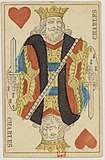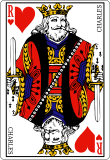French playing cards
French playing cards (jeu de cartes) or French-suited playing cards are cards that use the French suits of trèfles (clovers or clubs ♣), carreaux (tiles or diamonds ♦), cœurs (hearts ♥), and piques (pikes or spades ♠). Each suit contains three face cards; the valet (knave or jack), the dame (lady or queen), and the roi (king). Aside from these aspects, decks can include a wide variety of regional and national patterns which often have different deck sizes. In comparison to Spanish, Italian, German, and Swiss playing cards, French cards are the most widespread due to the geopolitical, commercial, and cultural influence of France, the United Kingdom, and the United States in the past two centuries. Other reasons for their popularity were the simplicity of the suit insignia, which simplifies mass production, and the popularity of whist and contract bridge. The English pattern of French-suited cards is so widespread that it is often also known as the International or Anglo-American pattern.
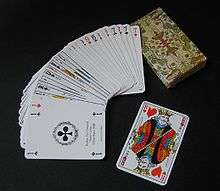
History
Playing cards arrived in Europe from Mamluk Egypt around 1370 and were already reported in France in 1377. The French suit insignia was derived from German suits around 1480. Between the transition from the suit of bells to tiles there was a suit of crescents.[1]
One of the most distinguishing features of the French cards is the queen. Mamluk cards and their derivatives, the Latin suited and German suited cards, all have three male face cards. Queens began appearing in Italian tarot decks in the mid-15th century and some German decks replaced two kings with queens. While other decks abandoned the queen in non-tarot decks, the French kept them and dropped the knight as the middle face card. Face card design was heavily influenced by Spanish cards that used to circulate in France. One of the most obvious traits inherited from Spain are the standing kings; kings from Italian, Portuguese, or Germanic cards are seated. Spanish-suited cards are still used in France, mostly in Northern Catalonia, and Brittany and the Vendée with the latter two using the archaic Aluette cards.
In the 19th century, corner indices and rounded corners were added and cards became reversible, relieving players from having to flip face cards right side up. The index for aces and face cards usually follow the local language but many decks of the Paris pattern use the numeral "1" for aces.
| German | Hearts |
Bells |
Acorns |
Leaves |
| French | Hearts |
Tiles |
Clovers |
Pikes |
 Deck celebrating the union of Brittany and France with Spanish suits but has queens instead of knights (Antoine de Logiriera of Toulouse, c.1500).
Deck celebrating the union of Brittany and France with Spanish suits but has queens instead of knights (Antoine de Logiriera of Toulouse, c.1500). A transitional deck with suits of hearts and crescents (François Clerc of Lyon, late 15th century).
A transitional deck with suits of hearts and crescents (François Clerc of Lyon, late 15th century).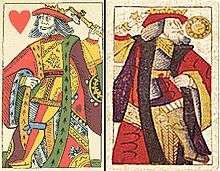 French Rouen pattern on the left, Spanish Toledo pattern on the right.
French Rouen pattern on the left, Spanish Toledo pattern on the right.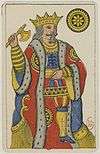 King of coins from Aluette, a Spanish-suited deck still in use in France. It is related to the Toledo pattern.
King of coins from Aluette, a Spanish-suited deck still in use in France. It is related to the Toledo pattern.
Current standard patterns
The French suited deck has spawned many regional variations known as standard patterns based on their artwork and deck size. The Paris pattern was heavily exported throughout continental Europe which is why most French-suited patterns share a similar appearance. The English pattern, based on the extinct Rouennais pattern, is the most well known pattern in the world. It is also called the International or Anglo-American pattern.
Note that patterns do not factor in Jokers as they are a very recent addition which leads to every manufacturer making their own trademarked depiction of this card. Almost all 52-card packs produced in the present will contain at least two jokers unless otherwise noted.
Paris pattern
The Paris pattern came to dominate in France around 1780 and became known as the portrait officiel. From the 19th century to 1945, the appearance of the cards used for domestic consumption was regulated by the French government. All cards were produced on watermarked paper made by the state to show payment of the stamp tax.[2] The most common deck sold in France is the 32-card deck with the 2 to 6 removed and 1s as the index for aces. 52-card decks are also popular. The French have a unique habit of associating their face cards with historic or mythical personages which survives only in the portrait officiel.[3]
| Rank/Suit | Spades | Hearts | Diamonds | Clubs |
|---|---|---|---|---|
| King | David | Charles[4] | Cesar | Alexandre |
| Queen | Pallas | Judith | Rachel[5] | Argine[6] |
| Jack | Hogier[7] | La Hire[8] | Hector | Lancelot[9] |
Belgian-Genoese and Piedmontese patterns
.jpg)
The Belgian-Genoese pattern is very similar to its Parisian parent and is basically an export version not subject to France's domestic stamp tax.[10][11] The jack of clubs has a triangular shield bearing the coat of arms of the former Spanish Netherlands, face cards are unnamed, and blue is usually replaced with green in the portraits. The diagonal dividing line also lacks the beads. When the Ottoman Empire relaxed the ban against playing cards, Belgian type cards flooded their territory and is now found throughout the Balkans, North Africa, and the Middle East. They are also commonly found in France's former colonies. Within Belgium, the Francophone Walloons are the primary users of this pattern, the Flemish prefer the Dutch pattern. This is the second most common pattern in the world after the English pattern. Belgian decks come in either 32 or 52 cards like in France.
Genoese type cards are identical to Belgian ones but lack corner indices. They come in 36 (no 2s to 5s), 40 (no 8s to 10s), or 52 card decks.
The Piedmontese pattern is similar to the Genoese packs but its face cards have a horizontal instead of diagonal dividing line and the aces are found in a decorative garland.[12][13] They also come in the same number of cards as Genoese ones. The Piedmontese pattern was once used in neighboring Savoy as both were previously united until France annexed the latter in 1860. A 78 card tarot version of the Piedmontese pattern, complete with knights, the fool, a suit of trumps depicting flowers, and corner indices, was printed in 1902 for Savoyard players. It was discontinued some time after 1910 but reproductions have been in print since 1984. The Chambéry rules that come with the deck are similar to Piedmontese tarot games but the ace ranked between the jack and the 10 like in Triomphe.[14][15][16] It should not be confused with the Italian-suited Piedmontese tarot.
Bavarian derivatives
A Parisian variant appeared in Bavaria in the mid-18th century where the king of diamonds wore a turban. This originates from the German-suited Old Bavarian pattern. The king of spades, who used to represent David, no longer holds a harp. This group is closely associated with animal tarots.

The Russian pattern created during the early 19th-century is based on a Baltic version of a Bavarian derivative.[17][18][19] The current appearance was finalized by Adolf Charlemagne. It usually contains 52 or 36 cards, the latter lacking ranks 2 to 5. The stripped deck is used to play Durak.[20] They can be found in many countries that were once part of the Russian Empire or Soviet Union.
Adler-Cego is the last remaining animal tarot and is used in Germany's Black Forest to play Cego. The courts are based on a Frankfurt version of a Bavarian derivative.[21] It is sold with 54 cards; the 5 to 10 of the red suits and the 1 to 6 of the black suits are removed. Real and fictional animals are displayed on the trump suit but despite its name, eagles do not appear. Trumps have a pink panel in each end with an Arabic numeral to show its rank.
The Industrie und Glück (Industry and Luck) tarock deck of Central Europe uses Roman numerals for the trumps. It is organized in the same manner as the Adler-Cego decks. Its trumps abandoned the traditional allegorical motifs found in Italian tarocchi decks in favor of new, more whimsical scenes like depictions of rural life.[22] The turban wearing king is now in the suit of spades.
Hamburg derivatives
French-suited cards are popular in Central Europe and compete very well against local German playing cards. Hamburg was once a major card-producing hub where makers began revising the Paris pattern. The patterns in this family have the king of spades keeping David's harp.

The North-German pattern was created in Stralsund from a Hamburg derivative. It is often erroneously called the Berlin pattern.[23] The crownless queens' hairstyles reflect the Biedermeier fashions of the day.[24] They are usually in decks of 32 cards with the twos to sixes missing since skat, Germany's most popular card game, does not require a full deck.[25] Decks of 36 cards (with the sixes) are for jass and tapp, a game played in Baden-Württemberg. Decks of 52 cards usually include three jokers but Zwickern decks have six jokers.
The French-Swiss pattern shares the same descent from the North-German pattern's Hamburg parent but their most distinguishing characteristic is that instead of having corner indices, white Arabic numerals are found within the pips closest to the corner.[26][27][28] French-Swiss cards comes only in decks of 36 with no ranks from two to five.
The Modern Portuguese pattern is a Parisian derivative from Germany. When it arrived in Portugal, the kings and jacks in hearts and diamonds swapped suits.[29][30] The composition consists of 52 cards or until recently 40 cards. The latter had an unusual ranking (ace, king, jack, queen, eight, six–two). The jack ranking higher than the queen comes from the older Portuguese games where a female knave was outranked by the knight.[31] They also use French-language indices.
The Dutch pattern originates from Germany and shares the same parent as the Modern Portuguese pattern but with different queens. It was not produced in the Netherlands until the 1970s. Their most distinguishing feature are scenic aces.[32][33] Also found in Flanders, they come in decks of 32 (no twos to sixes) or 52 cards.
The Trente et Quarante pattern is named after the game it is associated with.[34][35][36] Unlike other patterns, it is usually found only in casinos. Although of German origin, this pattern is now produced only in Italy. They consist of 52 cards and no indices.
Dondorf Rhineland pattern
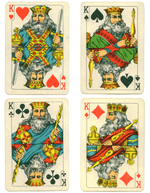
Around 1870, Dondorf of Frankfurt produced the Rhineland pattern. The kings have very thick beards. They have fallen out of popularity in Germany but are very common in Poland, Austria, the Netherlands, Denmark, and the Baltic states. They come in decks of 24 (no 2s to 8s), 32 (no 2s to 6s), or 52 cards, the latter of which may have up to three jokers in some countries.[37][38]
Tarot Nouveau
The Tarot Nouveau or Bourgeois Tarot was designed by C.L. Wüst of Frankfurt in the mid-19th century. It is popular in Francophone Europe and Quebec and is also used in Denmark to play tarot games that require the full 78-card deck. Like the Industrie und Glück, the trumps depict genre scenes but modern editions use Arabic numerals instead of Roman ones.[39]
Modern Swedish pattern
Swedes used to use Bavarian derived patterns. In the early 20th-century, the firm Öberg & Son invented a new pattern unrelated to the old ones.[40][41][42][43][44] This pattern has spread to neighboring Finland. The clothing for the figures in the court cards are color coordinated; green for spades, red for hearts, purple for clubs, and blue for diamonds. They are in the standard 52-card format.
English pattern

Card makers from Rouen began exporting to England around 1480.[45] Since Latin-suited cards were already circulating in England, the English renamed French suits to the Latin ones with which they were familiar. Hence the clovers were called clubs and pikes were named after the swords (spade). The English did not start producing their own cards until a century later. In 1628, the importation of foreign playing cards was banned to protect local manufacturers. English cardmakers produced lower quality cards than their continental counterparts leading to the loss of detail from the Rouennais pattern. Today's pattern is the result of Charles Goodall and Son's reworking of the old Rouen pattern during the 19th century.[46] The majority of decks sold in this pattern is the 52 card deck. One deck invented in the United States but more commonly found in Australia and New Zealand contains 11s, 12s, and red 13s to play the six-handed version of the Euchre variant 500.[47] In the late nineteenth century, they were also used for variants of draw poker and royal cassino.[48][49] Decks marketed for Canasta often have card point values printed on the cards.
Vienna pattern
.tif.jpg)
Lyon was a major card exporter to German speaking countries from the late 16th through the 18th centuries.[50][51] While the Lyonnais pattern died out in most places, it survived in Austria and the Czech Republic and its modern incarnation is the Vienna pattern.[52][53][54] They come in decks of 24 (no 2s to 8s), 32 (no 2s to 6s), or 52 cards, the latter with corner indices and three jokers.
Lombard pattern
The Lombard or Milanese pattern come in 40 card decks that is missing the 8s, 9s, and 10s and lack corner indices. The Lombard decks exported to Swiss Italian regions contain corner indices and also labels the ranks of the face cards.[55] It is probably derived from the Lyonnais pattern and its offshoot, the extinct Provence pattern.[56][57]
Tuscan pattern
The Tuscan or Florentine pattern, dating from the mid-19th century, is the only French suited deck that is not reversible in the present.[58][59] Cards measure 58 × 88 mm but the Toscane Grandi by Modiano are 67 × 101 mm large. It has the same composition of cards as the Lombard pattern. There was another pattern called "Tuscan" but it has ceased printing since the 1980s.[60][61]
Baronesse pattern
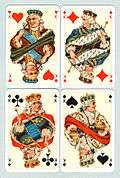
Dondorf of Frankfurt produced this pattern around 1900 and now it is used in Patience decks by many companies worldwide. The court cards are dressed in rococo period costumes.[62][63]
References
- Dummett, Michael (1980). The Game of Tarot. London: Duckworth. pp. 10–30.
- Belgian-Genoese pattern at the International Playing-Card Society. Retrieved 5 February 2016.
- Berry, John (1984). "The History of the Paris Pattern". The Playing-Card. 13 (1): 1–23.
- possibly Charlemagne, or Charles VII, in which case Rachel (see below) would be the pseudonym of his mistress, Agnès Sorel
- either biblical, historical (see Charles above)
- possibly an anagram of regina, which is Latin for queen, or perhaps Argea, wife of Polybus and mother of Argus
- a knight of Charlemagne
- comrade-in-arms to Joan of Arc, and member of Charles VII's court
- since 1813, from 1613–1813 this card carried the manufacturer's name, before 1613 it was Judas Maccabeus
- Belgian-Genoese pattern at the International Playing-Card Society. Retrieved 5 February 2016.
- Pollett, Andrea. Belgian and Genoese cards at Andy's Playing Cards. Retrieved 5 February 2016.
- The Piemont Pattern at Alta Carta. Retrieved 18 February 2016.
- Wintle, Simon. Piedmont Type at the World of Playing Cards. Retrieved 20 January 2018.
- Dummett, Michael; McLeod, John (2004). A History of Games Played with the Tarot Pack Volume I. Lewiston: The Edwin Mellen Press. pp. 174–178.
- Depaulis, Thierry (1984). Tarot, jeu et magie. Paris: Bibliothèque nationale de France. pp. 125–126.
- "Tarot Francais des Fleurs" at the World Web Playing Card Museum. Retrieved 20 January 2018.
- Mann, Sylvia. (1990) All Cards on the Table. Leinfelden: Deutsches Spielkarten-Museum. pp. 277-278.
- Wintle, Adam. Russian Standard Playing Cards at World of Playing Cards. Retrieved 5 February 2016.
- Russian Pattern at Alta Carta. Retrieved 5 February 2016.
- McLeod, John. Card Games in Russia at pagat.com. Retrieved 5 February 2016.
- Mann, Sylvia (1990). All Cards on the Table. Leinfelden: Deutsches Spielkarten-Museum. pp. 83, 315.
- Austrian Tarock Type C at the International Playing-Card Society. Retrieved 20 February 2016.
- North-German pattern at the International Playing-Card Society. Retrieved 10 September 2016.
- Wintle, Simon. North German pattern. Retrieved 5 January 2016.
- Berlin pattern at Alta Carta. Retrieved 5 February 2016.
- French-Swiss pattern at the International Playing-Card Society. Retrieved 15 February 2016.
- Pollett, Andrea. Switzerland: French-suited patterns at Andy's Playing Cards (archived). Retrieved 15 February 2016.
- Französischschweizer Spielkarten (German) at kartenhaus. Retrieved 15 February 2016.
- XP2 at the International Playing-Card Society. Retrieved 15 February 2016.
- Gámez, Manuel. Baraja de Fantasia at My Dear Playing Cards. Retrieved 8 October 2016.
- McLeod, John. Card games in Portugal at pagat.com. Retrieved 18 February 2016.
- Dutch pattern at the International Playing-Card Society. Retrieved 5 February 2016.
- The Netherlands Pattern at Alta Carta. Retrieved 5 February 2016.
- Trente et Quarante pattern at the International Playing-Card Society. Retrieved 5 February 2016.
- Casino pattern at Alta Carta. Retrieved 5 February 2016.
- Pollett, Andrea. Trente et Quarante cards at Andy's Playing Cards. Retrieved 5 February 2016.
- Dondorf Rhineland pattern at the International Playing-Card Society. Retrieved 5 February 2016.
- Wintle, Simon. Rhineland pattern at the World of Playing Cards. Retrieved 5 February 2016.
- Bourgeois Tarot at the International Playing-Card Society. Retrieved 17 February 2016.
- Mann, Sylvia. (1990). All Cards on the Table. Leinfelden: Deutsches Spielkarten-Museum. p. 153.
- Wintle, Simon. Standard Swedish Pattern at World of Playing Cards. Retrieved 5 February 2016.
- The Swedish Pattern at Alta Carta. Retrieved 5 February 2016.
- Pollett, Andrea. Sweden at Andy's Playing Cards (archived).
- Modern Swedish pattern at the International Playing-Card Society. Retrieved 7 September 2016.
- English pattern at the International Playing-Card Society. Retrieved 5 February 2016.
- Wintle, Adam. Charles Goodall and Son at the World of Playing Cards. Retrieved 5 February 2016.
- McLeod, John. Five Hundred at Pagat.com. Retrieved 31 January 2017.
- Burton, Jeffrey (1999). "French Suited 60-Card Decks". The Playing-Card. 28 (2): 63–64.
- Pratesi, Franco (1995). "Casino from nowhere, to vaguely everywhere". The Playing-Card. 24 (1): 10.
- portrait d'Allemagne at the International Playing-Card Society. Retrieved 5 February 2016.
- Wintle, Simon. Lyons pattern type iii at the World of Playing Cards. Retrieved 27 September 2016.
- Wintle, Simon. Wiener pattern at the World of Playing Cards. Retrieved 5 February 2016.
- Vienna pattern at Alta Carta. Retrieved 5 February 2016.
- Vienna pattern, large crown at the International Playing-Card Society. Retrieved 7 September 2016.
- Lombard pattern at Alta Carta. Retrieved 5 February 2016.
- Wintle, Simon. Lombardy Type at World of Playing Cards. Retrieved 5 February 2016.
- Mann, Sylvia. (1990) All Cards on the Table. Leinfelden: Deutsches Spielkarten-Museum. pp.43-44.
- Wintle, Adam. Florentine type at the World of Playing Cards. Retrieved 18 February 2016.
- Tuscan pattern at Alta Carta. Retrieved 5 February 2016.
- Mann, Sylvia (1990). All Cards on the Table. Leinfelden: Deutsches Spielkarten-Museum. pp. 44–45, 301–303.
- Old Tuscany Pattern at Alta Carta. Retrieved 25 September 2016.
- Mann, Sylvia. (1990). All Cards on the Table. Leinfelden: Deutsches Spielkarten-Museum. p.77, 300.
- Wintle, Simon. Baronesse Whist No.160 at the World of Playing Cards. Retrieved 20 February 2016.


